Wear Comfort Characteristics of Al2O3/ATO/TiO2-Embedded Multi-Functional PET Fabrics
Abstract
:1. Introduction
2. Materials and Methods
2.1. Preparation of Yarn Specimens
2.2. Preparation of the Fabric Specimens
2.3. FIR Analysis of the Yarn Specimens
2.4. Thermal Radiation Measurement
2.5. Moisture Absorption and Drying Properties Using the Moisture Management Tester (MMT)
2.6. Measurement of the Thermal Conductivity and Heat Retention Rate
2.7. Measurement of the Moisture Vapor Resistance
3. Results and Discussion
3.1. Characteristics of the Al2O3/ATO/TiO2-Embedded Sheath/Core Yarns
3.2. FIR Characteristics and Thermal Radiation of the Ceramic-Particle-Embedded Yarns and Fabrics
3.3. Moisture Absorption and Drying Properties by MMT
3.4. Thermal Characteristics of Al2O3/ATO-Embedded Fabrics
3.5. Moisture Vapor Resistance of the Al2O3/ATO-Embedded Fabrics
4. Conclusions
Funding
Institutional Review Board Statement
Informed Consent Statement
Data Availability Statement
Conflicts of Interest
References
- Broadbent, A.D.; Cote, B.; Fecteau, T.; Khatibi-Sarabi, P.; Therien, N. Predrying textile fabrics with infrared radiation. Text. Res. J. 1994, 64, 123–129. [Google Scholar] [CrossRef]
- Car, W.W.; Sarma, D.S.; Johnson, M.R.; Do, B.T.; Williamson, V.A.; Perkins, W.A. Infrared absorption studies of fabrics. Text. Res. J. 1997, 67, 725–738. [Google Scholar] [CrossRef]
- McFarland, E.G.; Carr, W.W.; Sarma, D.S.; Dorrity, J.L. Effects of moisture and fiber type on infrared absorption of fabrics. Text. Res. J. 1999, 69, 607–615. [Google Scholar] [CrossRef]
- Xu, W.; Shyr, T.; Yao, M. Textile’s properties in the infrared irradiation. Text. Res. J. 2007, 77, 513–519. [Google Scholar] [CrossRef]
- Furuta, T.; Shimizu, Y.; Kondo, Y. Evaluating the temperature and humidity characteristics of solar energy absorbing and retaining fabric. Text. Res. J. 1996, 66, 123–130. [Google Scholar] [CrossRef]
- Pooley, M.A.; Anderson, D.M.; Beckham, H.W.; Brennan, J.F., III. Engineered emissivity of textile fabrics by the inclusion of ceramic particles. Opt. Express 2016, 24, 10556–10564. [Google Scholar] [CrossRef] [Green Version]
- Anderson, D.M.; Fessler, J.R.; Pooley, M.A.; Seidel, S.; Hamblin, M.R.; Beckhan, H.W.; Brennan, J.F., III. Infrared radiative properties and thermal modeling of ceramic-imbedded textile fabric. Biomed. Opt. Express 2017, 8, 1698–1711. [Google Scholar] [CrossRef] [Green Version]
- Bahng, G.W.; Lee, J.D. Development of heat-generating polyester fiber harnessing catalytic ceramic powder combined with heat-generating super microorganisms. Text. Res. J. 2014, 84, 1220–1230. [Google Scholar] [CrossRef]
- Kim, H.A.; Kim, S.J. Wear comfort properties of ZrC/Al2O3/graphite-embedded heat-storage woven fabrics for garments. Text. Res. J. 2019, 89, 1394–1407. [Google Scholar] [CrossRef]
- Desant, Ltd.; Unitkca, Ltd. Solar-Energy Selective Absorbing and Retaining Fiber. Japanese Patent (Kokoku) 3-9202, 1991. [Google Scholar]
- Kim, H.A.; Kim, S.J. Far-infrared emission characteristics and wear comfort property of ZrC-imbedded heat storage knitted fabrics for emotional garment. Autex Res. J. 2017, 17, 142–151. [Google Scholar] [CrossRef]
- Kim, H.A.; Kim, S.J. Heat storage and release characteristics of ceramic-imbedded woven fabric for emotional clothing. Autex Res. J. 2019, 19, 165–172. [Google Scholar] [CrossRef] [Green Version]
- Ihara, H. Electron Structure of Transition Metal Carbides and Borate by X-ray Photoelectron Spectroscopy and Band Calculation; Technical report of electro-technical laboratory, no.775; Ministry of International Trade and Industry of Japan: Tokyo, Japan, 1978; pp. 106–109.
- Gigyustsuin, K. Light Selective Absorbing Materials. Japanese Patent (Kokoku) 55-038582, 1980. [Google Scholar]
- Lin, C.A.; An, T.C.; Hsu, Y.H. Study on the far infrared ray emission property and absorption performance of bamboo charcoal/polyvinyl alcohol fiber. Polym.-Plast. Technol. Eng. 2007, 46, 1073–1078. [Google Scholar] [CrossRef]
- Kuo, C.F.J.; Fan, C.C.; Su, T.L.; Chen, S.H.; Lan, W.L. Nano composite fiber process optimization for polypropylene with antibacterial and far-infrared ray emission properties. Text. Res. J. 2016, 86, 1677–1687. [Google Scholar] [CrossRef]
- Wong, Y.W.H.; Yuen, C.W.M.; Leung, M.Y.S.; Ku, S.K.A.; Lam, H.L.I. Selected applications of nanotechnology in textile. Autex Res. J. 2006, 6, 1–8. [Google Scholar]
- Xin, J.J.; Daoud, W.A.; Kong, Y.Y. A new approach to UV-Blocking treatment for cotton fabrics. Text. Res. J. 2004, 74, 97–100. [Google Scholar] [CrossRef]
- Bumiston, N.; Bygott, C.; Stratton, J. Nano technology meets titanium dioxide. Surf. Coat. Int. Part A 2004, 87, 179–184. [Google Scholar]
- Sherman, J. Nanoparticle Titanium Dioxide Coating and Processes for the Production and Use Thereof. U.S. Patent 6653356B2, 2003. [Google Scholar]
- Yang, H.Y.; Zhu, S.K.; Pan, N. Studying the mechanisms of titanium dioxide as ultraviolet-blocking additive for films and fabrics by and improved scheme. J. Appl. Polym. Sci. 2003, 92, 3201–3210. [Google Scholar] [CrossRef]
- Saito, M. Antibacterial, deodorizing, and UV absorbing materials obtained with zinc oxide (ZnO) coated fabrics. J. Coat. Fabr. 1993, 23, 150–164. [Google Scholar] [CrossRef]
- Xiong, M.N.; Gu, G.X.; You, B.; Wu, L.M. Preparation and characterization of poly (styrenebutylacrylate) latex/nano-ZnO nanocomposites. J. Appl. Polym. Sci. 2003, 90, 1923–1931. [Google Scholar] [CrossRef]
- Wang, R.H.; Xin, J.J.; Tao, X.M.; Daoud, W.A. ZnO nanorods grown on cotton fabrics at low temperature. Chem. Phys. Lett. 2004, 398, 250–255. [Google Scholar] [CrossRef]
- Deopura, B.L.; Alagirusamy, R.; Joshi, M.; Gupta, B. Polyesters and Polyamides, 1st ed.; Woodhead Publishing Limited: Cambridge, UK, 2008; pp. 171–199. [Google Scholar]
- Dong, W.G.; Huang, G. Research on properties of nano polypropylene/TiO2 composite fiber. Text. Res. J. 2002, 23, 22–23. [Google Scholar]
- Wu, Y.; Chi, Y.B.; Nie, J.X.; Yu, A.P.; Chen, X.H.; Gu, H.C. Preparation and application of novel fabric finishing agent containing nano ATO. J. Funct. Polym. 2002, 15, 43–47. [Google Scholar]
- Ahn, T.X.; Tung, D.T.; Nhan, D.Q.; Hoang, T.V.; Trung, D.Q.; Thu, L.D.; Hoang, P.H.; Cuong, N.D. Study of ATO nanoparticles by the solvothermal method for thermal insulated coated glass: A green energy application. Green Process. Synth. 2016, 5, 529–535. [Google Scholar] [CrossRef]
- Sun, H.; Liu, X.; Liu, B.; Yin, Z. Preparation and properties of antimony doped tin oxide nanopowders and their conductivity. Mater. Res. Bull. 2016, 83, 354–359. [Google Scholar] [CrossRef]
- Muller, V.; Rathousky, J.; Rasp, M.; Stefanic, G.; Gunter, S.; Niederberger, M.; Fattakhova-Rohlfing, D. Highly conducting nanosized monodispersed antimony-doped tin oxide particles synthesized via nonaqueous sol-gel method. NSTI-Nanotech. 2010, 1, 340–343. [Google Scholar]
- Crown, E.M.; Dale, J.D. Protection for workers in the oil and gas industries. In Textiles for Protection; The Textile Institute: Manchester, UK; Woodhead Publishing Limited: Cambridge, UK; CRC Press: Boca Raton, FL, USA, 2005; pp. 699–713. [Google Scholar]
- Sarkar, A.K. Textiles for UV protection. In Textiles for Protection; The Textile Institute: Manchester, UK; Woodhead Publishing Limited: Cambridge, UK; CRC Press: Boca Raton, FL, USA, 2005; pp. 355–377. [Google Scholar]
- Kim, H.A. Ultra-violet protection and anti-static characteristics with heat release/shielding of Al2O3/ATO/TiO2-imbedded multi-functional fabrics. Materials 2022, 15, 3652. [Google Scholar] [CrossRef] [PubMed]
- Hu, J.Y.; Li, Y.; Yeung, K.W.; Wong, A.; W, X. Moisture management tester: A method to characterize fabric liquid moisture management properties. Text. Res. J. 2005, 75, 57–62. [Google Scholar] [CrossRef]
- AATCC. Test Method 15, “Colorfastness to Perspiration”; AATCC: Research Triangle Park, NC, USA, 2002. [Google Scholar]
- Kim, H.A. Moisture vapor permeability and thermal wear comfort of eco-friendly fiber-embedded woven fabrics for high-performance clothing. Materials 2021, 14, 6205. [Google Scholar] [CrossRef]
- Fan, J.; Hunter, L. Engineering Apparel Fabrics and Garments; The Textile Institute: Manchester, UK; Woodhead Publishing Limited: Cambridge, UK; CRC Press: Boca Raton, FL, USA, 2009; pp. 309–338. [Google Scholar]
- Lin, C.M.; Chang, C.W. Production of thermal insulation composites containing bamboo charcoal. Text. Res. J. 2008, 78, 555–560. [Google Scholar] [CrossRef]
- Lin, J.H.; Huang, C.L.; Lin, Z.I.; Lou, C.W. Far-infrared emissive polyprophylene/wood flour plastic composites: Manufacturing technique and property evaluations. J. Comp. Mat. 2016, 50, 2099–2109. [Google Scholar] [CrossRef]
- Lin, J.H.; Jhang, C.L.; Lin, T.A.; Huang, S.Y.; Chen, Y.S.; Lou, C.W. Manufacturing techniques, mechanical properties, far infrared emissivity, and electromagnetic shielding effectiveness of stainless steel/polyester/bamboo charcoal knits. Fibers Polym. 2017, 18, 597–604. [Google Scholar] [CrossRef]
- Kwon, O.K. Development Trend on the Mechanism of Heat Transfer and Heat Keepability for Textiles. Available online: http://super.textopia.or.kr:8090/new/ktdi2/ktdi2021?no=000000030505 (accessed on 6 August 2021).
- Fuji. Fuji Technical Information. Available online: http://www.fuji-pigment.co.jp (accessed on 15 August 2021).
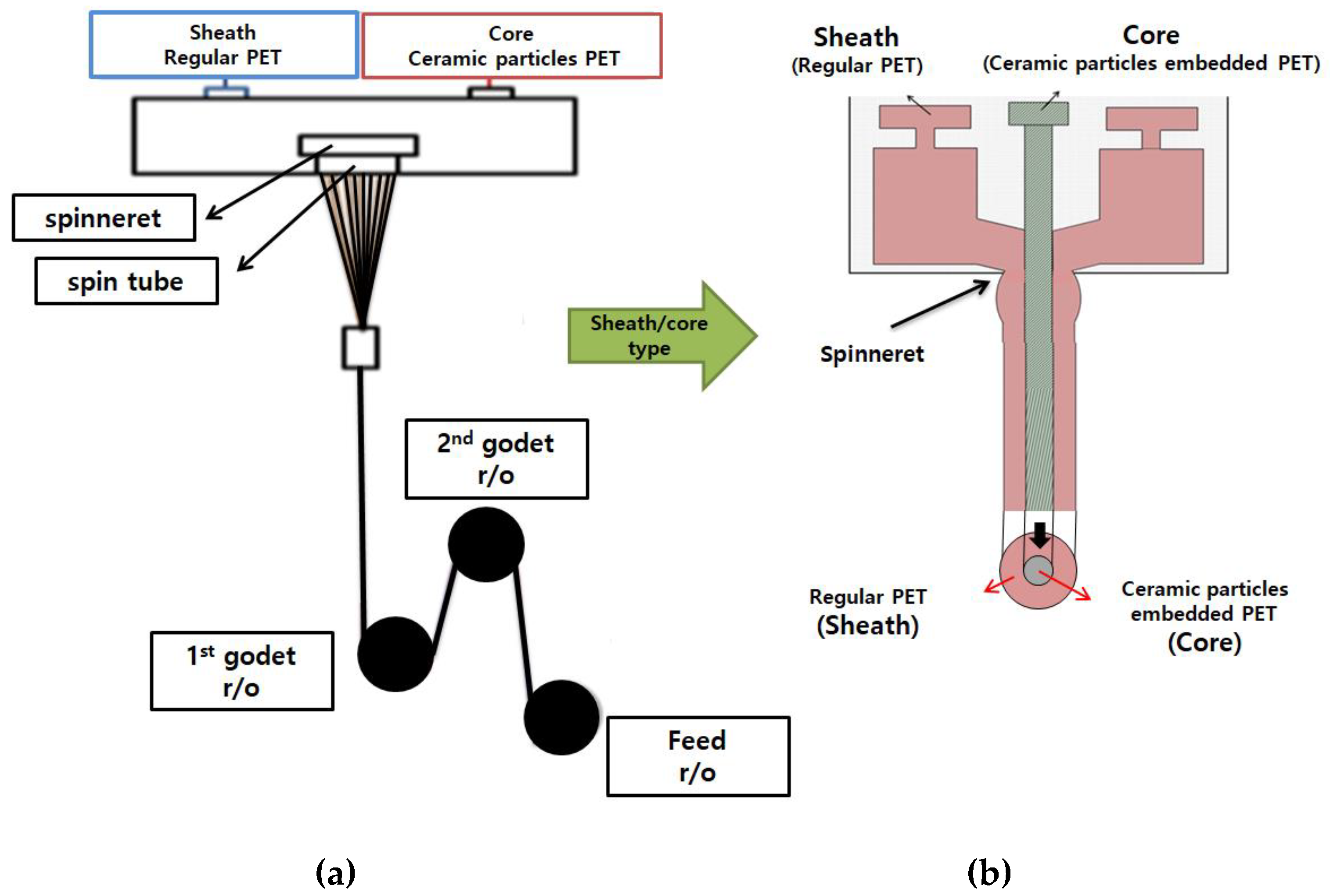
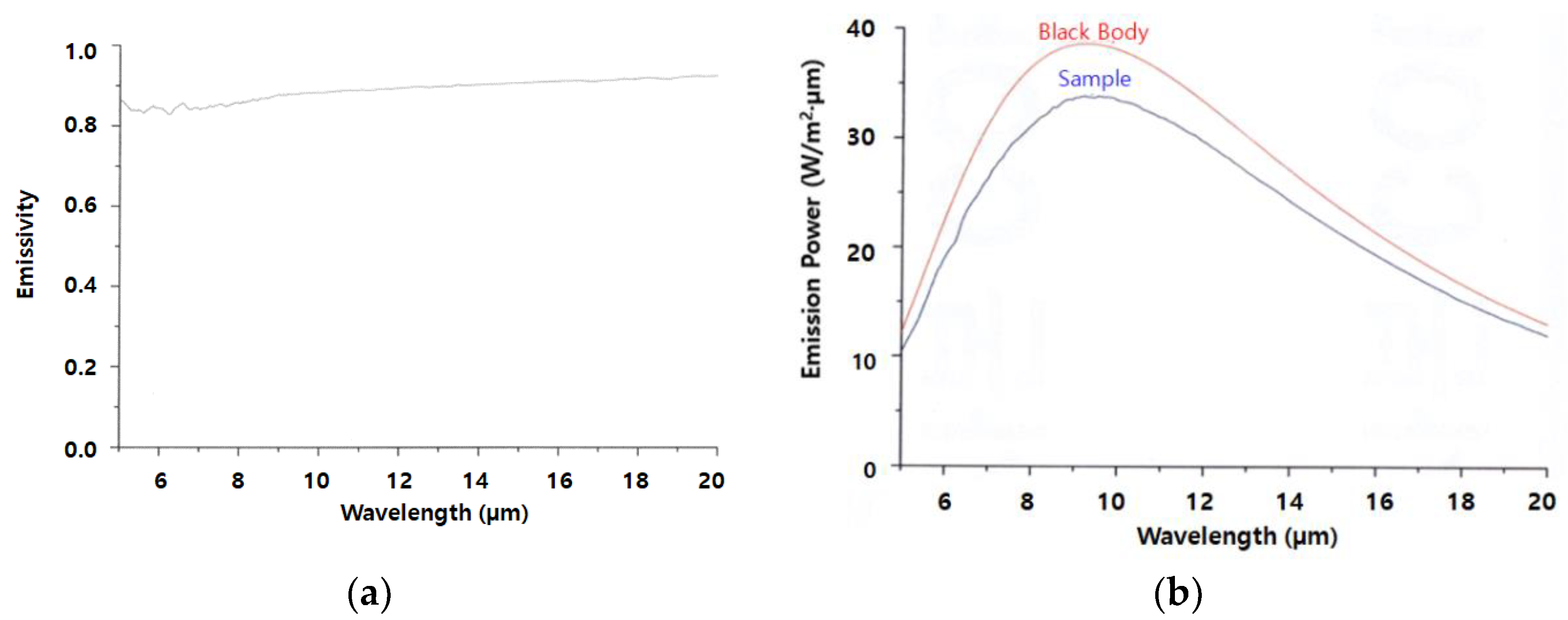
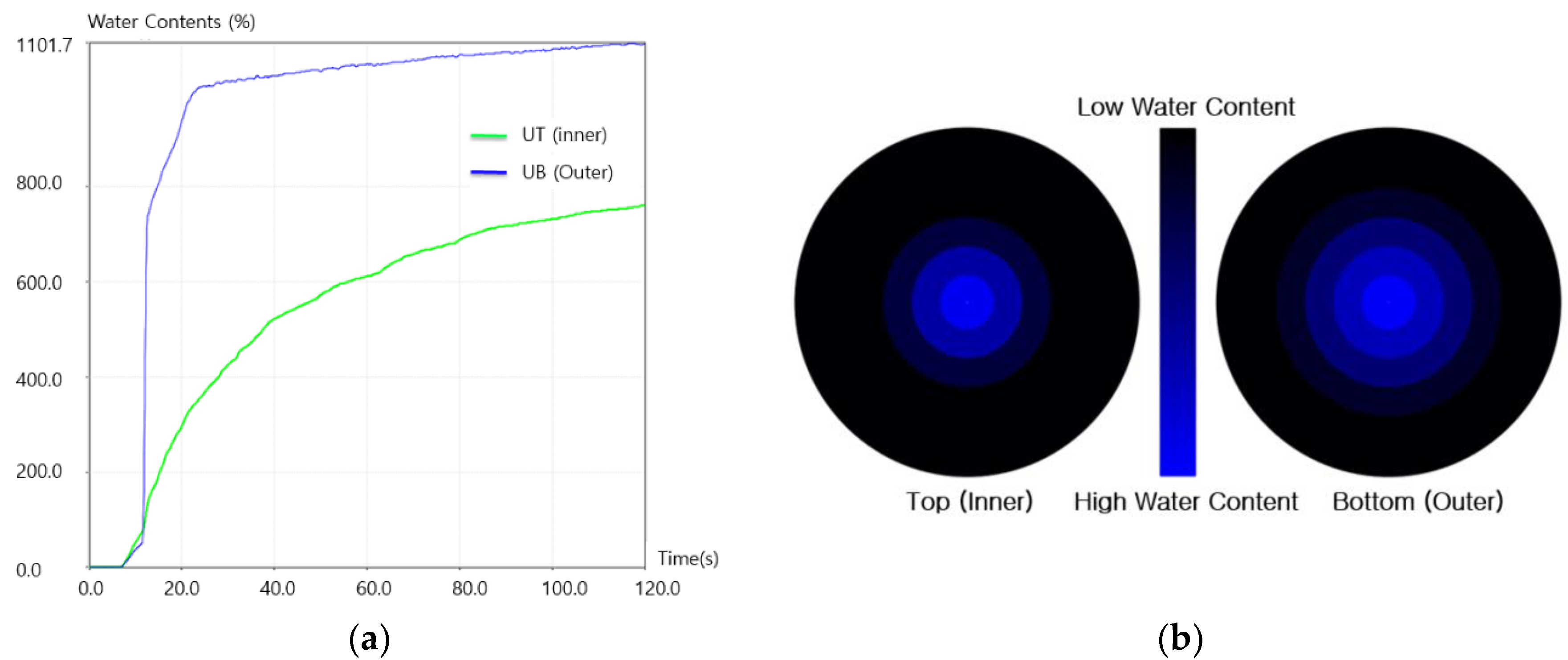



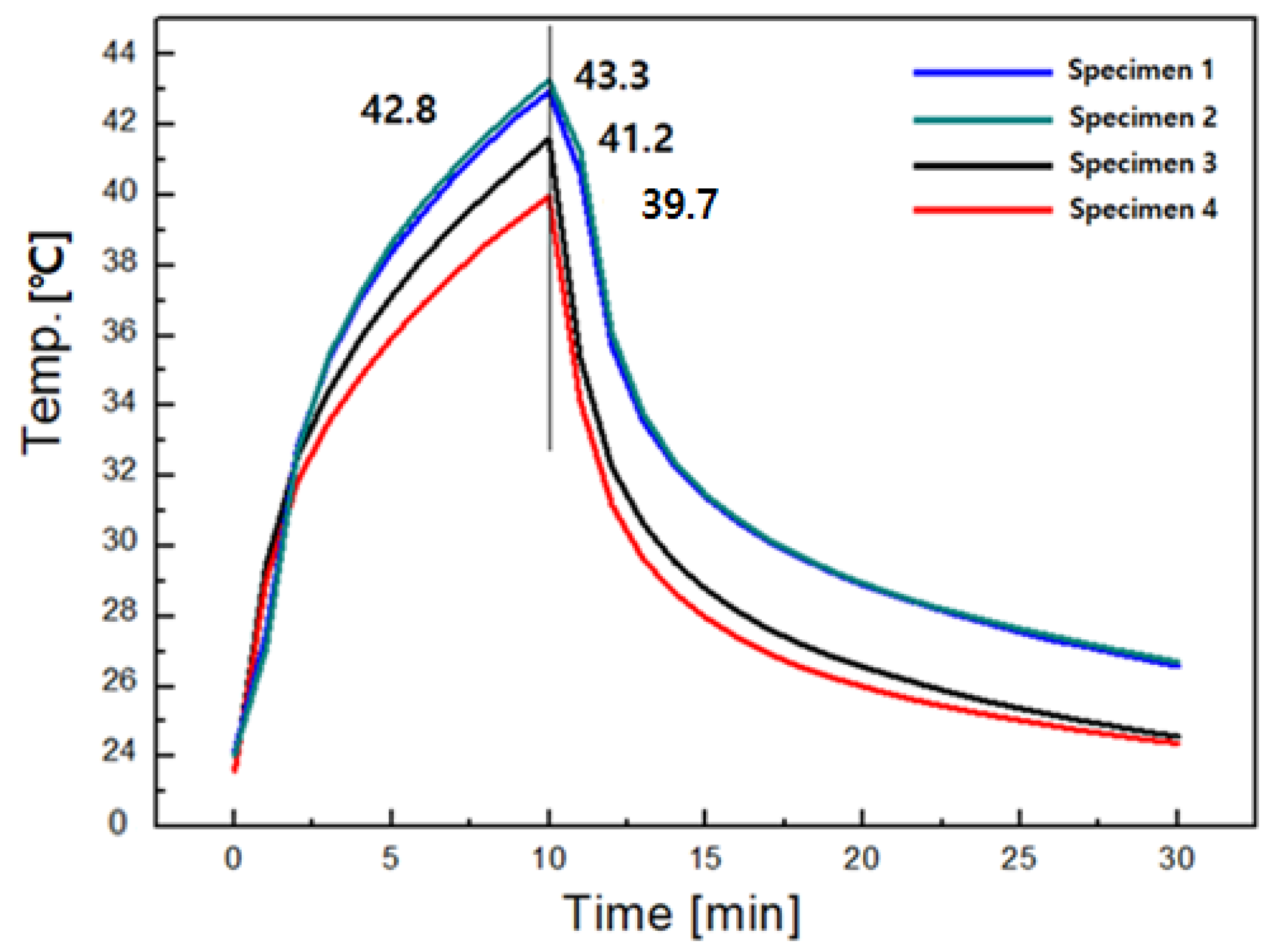
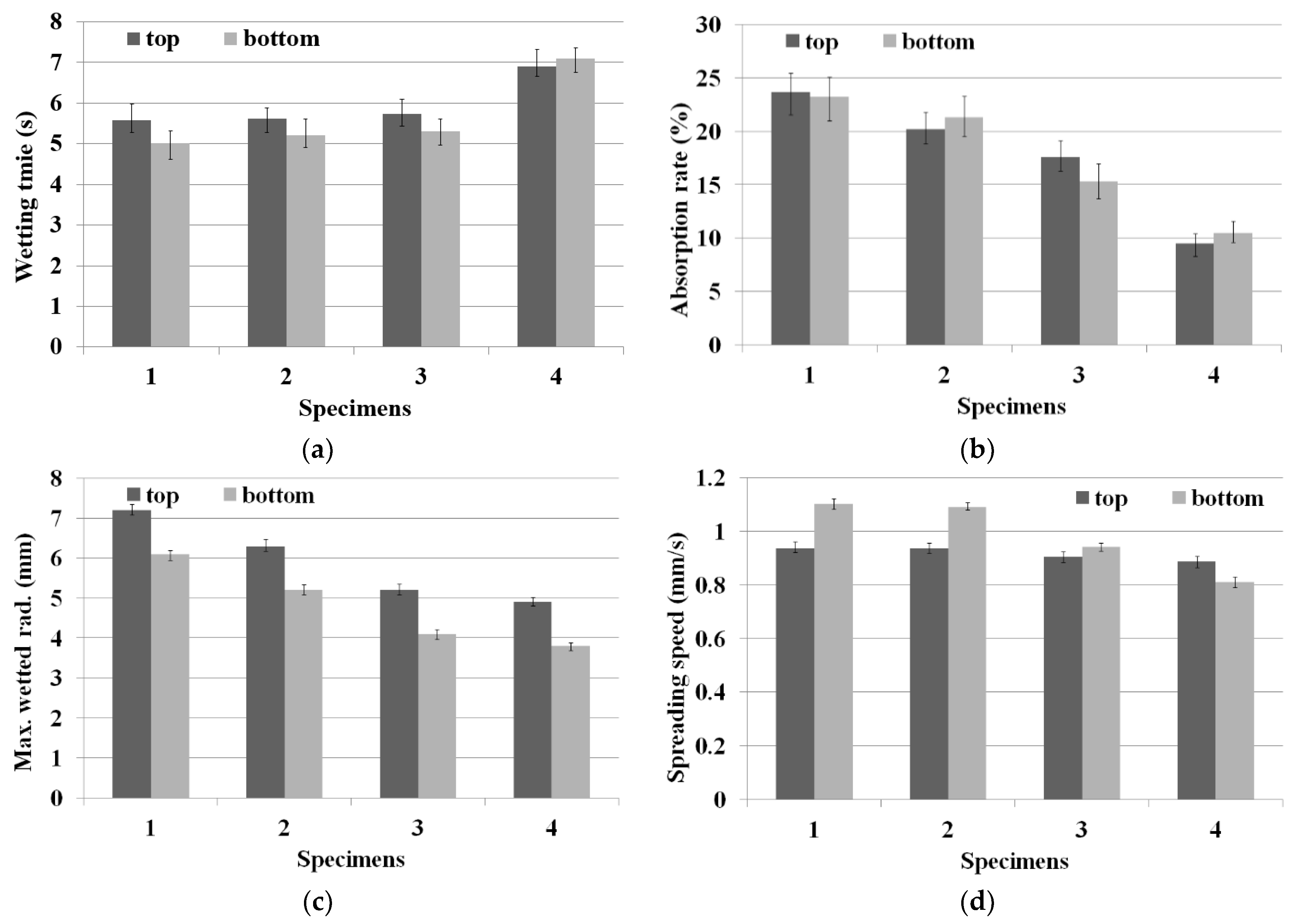


| M/B Chip | Al2O3 Chips | ATO Chips | PET Chips (TiO2) | |
|---|---|---|---|---|
| Characteristics | ||||
| Concentration (wt. %) | 20 | 20 | 0.36 | |
| Average size (nm) of ceramic particles | 869 | 200–300 | 400–500 | |
| M/B shape (chip) |  |  |  | |
| SEM images of the ceramic particles |  |  | Specification
| |
| PET Chip Weight (kg) | M/B Chip Weight (kg) | Mixed Polymer Weight (kg) | Mixing Ratio of M/B (wt. %) | ||||
|---|---|---|---|---|---|---|---|
| Al2O3ATO | Al2O3 | ATO | Total | ||||
| Al2O3/ATO embedded PET M/B | 47.25 | 2 | 0.75 | 50 | 0.8 | 0.3 | 1.1 |
| Al2O3/ATO embedded PET yarn specimen | Yarn specimen 1 | Yarn specimen 2 | Yarn specimen 3 | Yarn specimen 4 | |||
| Sheath/core ratio (5:5) | Sheath/core ratio (4:6) | Sheath/core ratio (3:7) | Regular PET | ||||
| Fabric Specimen No. | Yarn Count (d/f) | Sheath: Core (S/C) Ratio | Fabric Density (Picks, Ends/in) | Thickness | Weight | Weave Structure | ||
|---|---|---|---|---|---|---|---|---|
| Wp | Wf | Wp | Wf | (mm) | (g/m2) | |||
| 1 | PET 50/72 | Al2O3/ATO S/C PET 50/24 | 5:5 | 154 | 100 | 0.13 | 85.4 | plain |
| 2 | PET 50/72 | 4:6 | 154 | 100 | 0.12 | 84.8 | ||
| 3 | PET 50/72 | 3:7 | 154 | 100 | 0.13 | 85.6 | ||
| 4 | PET 50/72 | Reg PET 50/72 | - | 154 | 100 | 0.12 | 84.2 | |
| Specimen | Specimen 1 | Specimen 2 | Specimen 3 | Specimen 4 | ||||
|---|---|---|---|---|---|---|---|---|
| Mean | Dev. | Mean | Dev. | Mean | Dev. | Mean | Dev. | |
| Emissivity | 0.885 | 0.1 × 10−3 | 0.884 | 0.2 × 10−3 | 0.882 | 0.1 × 10−3 | 0.866 | 0.2 × 10−3 |
| Emissive power (W/m2·μm) | 3.44 × 102 | 0.001 × 102 | 3.43 × 102 | 0.002 × 102 | 3.42 × 102 | 0.001 × 102 | 3.40 × 102 | 0.001 × 102 |
| F-Value (F0) | F (3, 16, 0.95) | p-Value | |
|---|---|---|---|
| Emissivity | 12.02 | 3.239 | 2.27 × 10−4 |
| Emissive power | 3091.65 | 3.239 | 2.58 × 10−22 |
| Specimens No. | Wetting Time (s) | Absorption Rate (%) | Max.Wetted Rad.(mm) | Spreading Speed (mm/s) | |||||
|---|---|---|---|---|---|---|---|---|---|
| Top | Bottom | Top | Bottom | Top | Bottom | Top | Bottom | ||
| 1 | Al2O3/ATO S/C 5:5 | 5.580 | 5.011 | 23.635 | 23.20 | 7.2 | 6.1 | 0.9362 | 1.102 |
| 2 | Al2O3/ATO S/C 4:6 | 5.625 | 5.213 | 20.204 | 21.30 | 6.3 | 5.2 | 0.9360 | 1.091 |
| 3 | Al2O3/ATO S/C 3:7 | 5.737 | 5.312 | 17.622 | 15.30 | 5.2 | 4.1 | 0.9040 | 0.942 |
| 4 | Regular PET fabric | 6.912 | 7.102 | 9.504 | 10.50 | 4.9 | 3.8 | 0.8880 | 0.810 |
| Absorption and Drying Properties | F-Value (F0) | F (3, 16, 0.99) | p-Value | |
|---|---|---|---|---|
| Wetting time (s) | top | 29.50 | 5.292 | 9.38 × 10−7 |
| bottom | 70.36 | 5.292 | 1.96 × 10−9 | |
| Absorption rate (%) | top | 130.80 | 5.292 | 1.82 × 10−11 |
| bottom | 93.69 | 5.292 | 2.31 × 10−10 | |
| Max.wetted rad. (mm) | top | 380.55 | 5.292 | 4.42 × 10−15 |
| bottom | 613.86 | 5.292 | 1.01 × 10−16 | |
| Spreading speed (mm/s) | top | 11.91 | 5.292 | 2.38 × 10−4 |
| bottom | 543.26 | 5.292 | 2.65 × 10−16 | |
| Specimens/Properties | Specimen 1 | Specimen 2 | Specimen 3 | Specimen 4 | |
|---|---|---|---|---|---|
| Al2O3/ATO S/C 5:5 | Al2O3/ATO S/C 4:6 | Al2O3/ATO S/C 3:7 | Regular PET | ||
| Mean | Mean | Mean | Mean | ||
| Dry thermal properties | I (%) | 38.60 | 38.20 | 37.20 | 35.40 |
| K (W/cm °C) | 0.0278 | 0.0271 | 0.0264 | 0.0245 | |
| Wet thermal property | Ret(m2 Pa/W) | 1.94 | 2.70 | 2.81 | 3.15 |
| Dry and Wet Thermal Properties | F-Value (F0) | F (3, 16, 0.95) | p-Value |
|---|---|---|---|
| I (%) | 43.13 | 3.239 | 6.82 × 10−8 |
| K (W/cm °C) | 4.01 | 3.239 | 0.0263 |
| Ret(m2 Pa/W) | 45.19 | 3.239 | 4.90 × 10−8 |
Publisher’s Note: MDPI stays neutral with regard to jurisdictional claims in published maps and institutional affiliations. |
© 2022 by the author. Licensee MDPI, Basel, Switzerland. This article is an open access article distributed under the terms and conditions of the Creative Commons Attribution (CC BY) license (https://creativecommons.org/licenses/by/4.0/).
Share and Cite
Kim, H.-A. Wear Comfort Characteristics of Al2O3/ATO/TiO2-Embedded Multi-Functional PET Fabrics. Materials 2022, 15, 8799. https://doi.org/10.3390/ma15248799
Kim H-A. Wear Comfort Characteristics of Al2O3/ATO/TiO2-Embedded Multi-Functional PET Fabrics. Materials. 2022; 15(24):8799. https://doi.org/10.3390/ma15248799
Chicago/Turabian StyleKim, Hyun-Ah. 2022. "Wear Comfort Characteristics of Al2O3/ATO/TiO2-Embedded Multi-Functional PET Fabrics" Materials 15, no. 24: 8799. https://doi.org/10.3390/ma15248799




